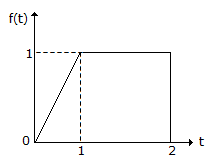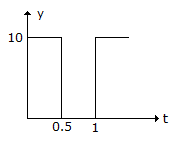Electronics and Communication Engineering - Signals and Systems
Exercise : Signals and Systems - Section 3
- Signals and Systems - Section 1
- Signals and Systems - Section 2
- Signals and Systems - Section 3
- Signals and Systems - Section 4
- Signals and Systems - Section 5
- Signals and Systems - Section 6
- Signals and Systems - Section 7
- Signals and Systems - Section 8
- Signals and Systems - Section 9
- Signals and Systems - Section 10
6.
The function f(t) in the given figure will have its Laplace transform as


Answer: Option
Explanation:
The function is sum of three functions , i.e., a ramp of slpoe 1 originating at t = 0, a ramp of slpoe - 1
Originating at t = 1 and a negative unit step function originating at t = 2, i.e.,
f(t) = tu(t) - t u(t -1) = u(-2)
 .
.
7.
The joint probability function of two discrete random variable X and Y is given by
 x = 0, 2, y = 2, 3 then E(X) =
x = 0, 2, y = 2, 3 then E(X) =
 x = 0, 2, y = 2, 3 then E(X) =
x = 0, 2, y = 2, 3 then E(X) =Answer: Option
Explanation:




 .
.
8.
The effective value of the waveform in the given figure is


Answer: Option
Explanation:
 .
.
9.
Which one of following is a static system?
Answer: Option
Explanation:
Output depend upon only present input while in other cases depend upon past input also

10.
The Laplace transform of unit ramp function starting at t = a is
Answer: Option
Explanation:
£f(t) = 
£-1F(s) = f(t)
£[a f1(t) + bf2(t)] = aF1(s) + bF2(s)



where 
£[f(t - T)] = e-sT F(s)
£[e-at f(t)] = F(s + a)
Initial value theorem 
Final value theroem 
Convolution Integral 

where t is dummy variable for t.
Quick links
Quantitative Aptitude
Verbal (English)
Reasoning
Programming
Interview
Placement Papers













